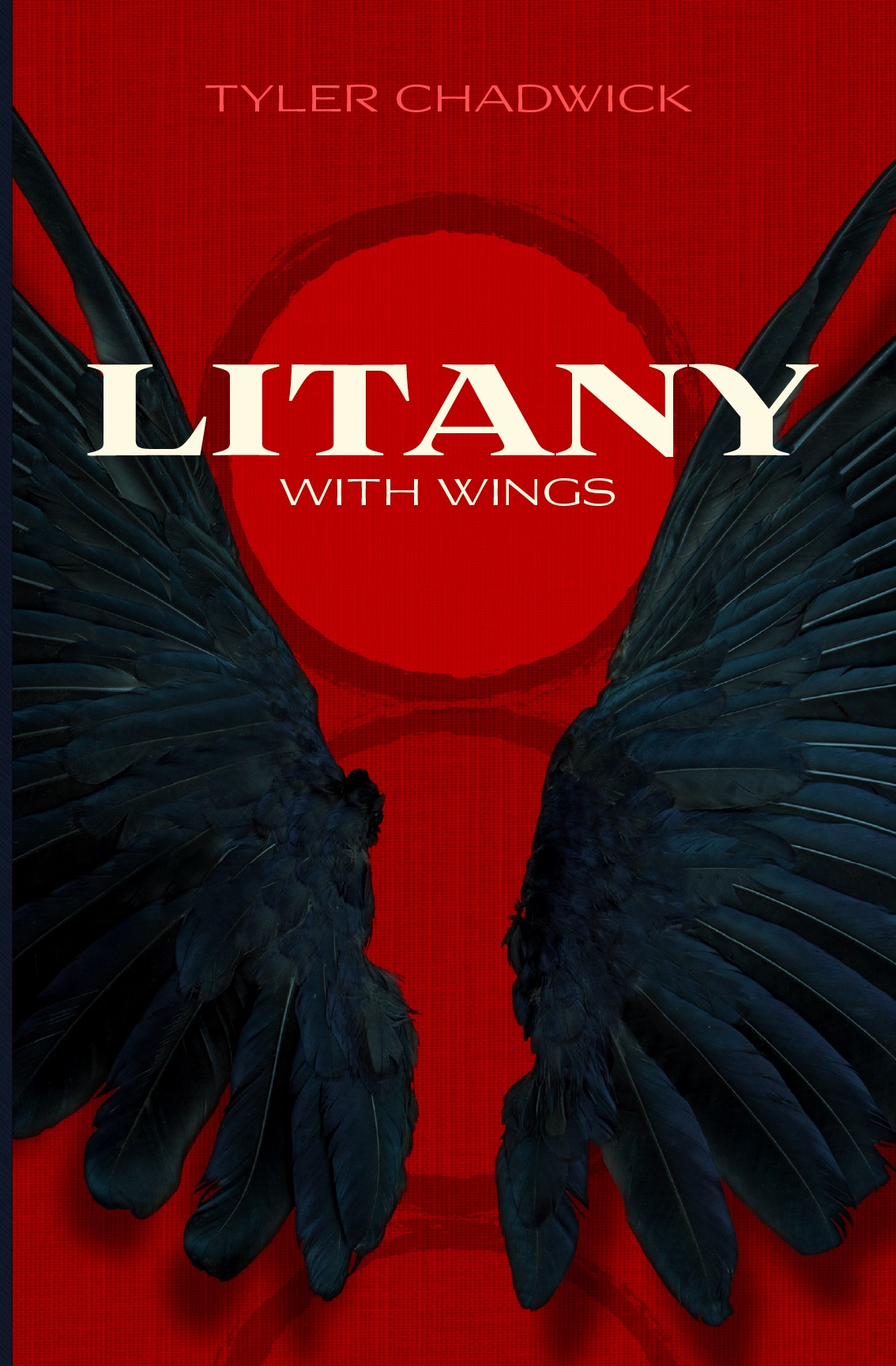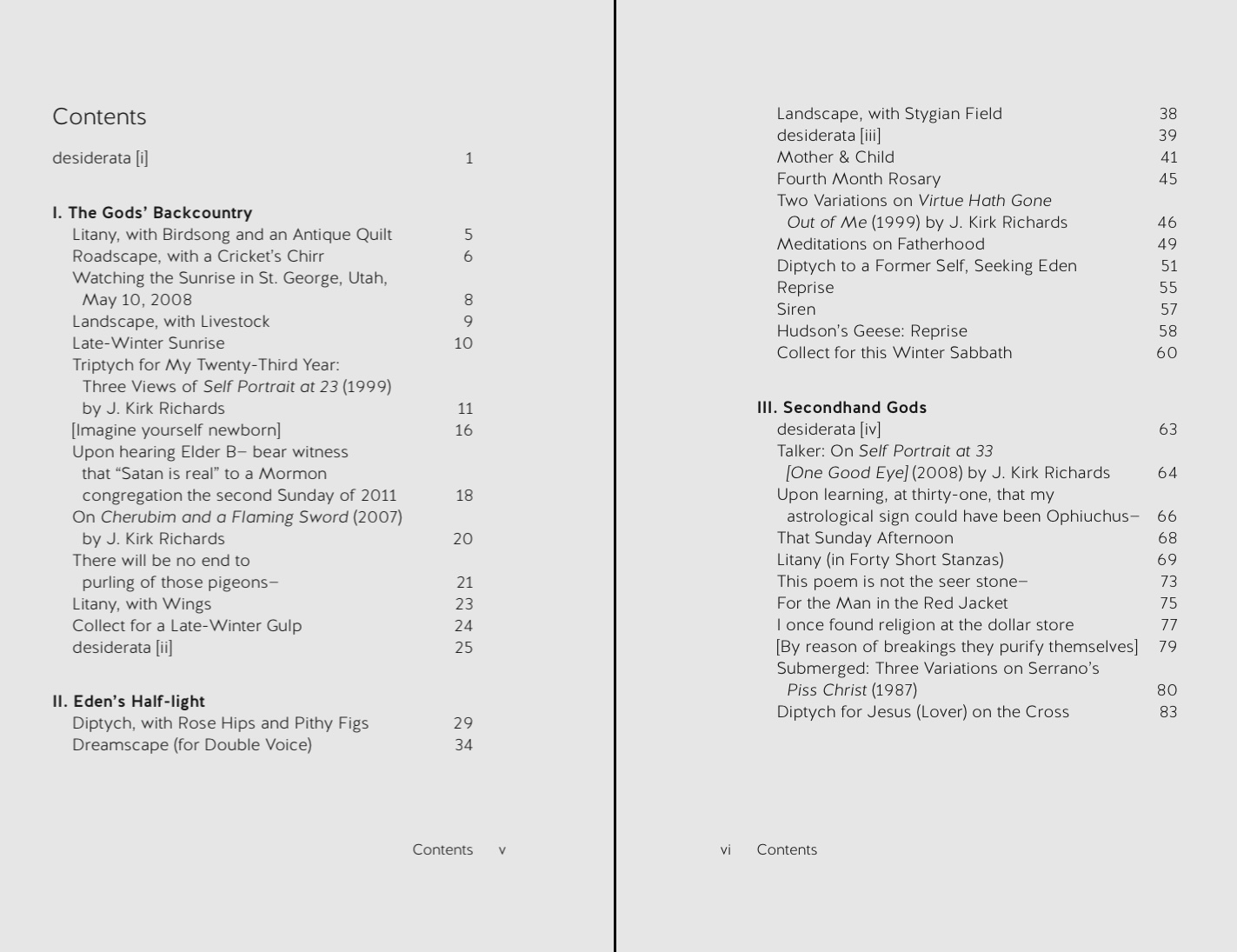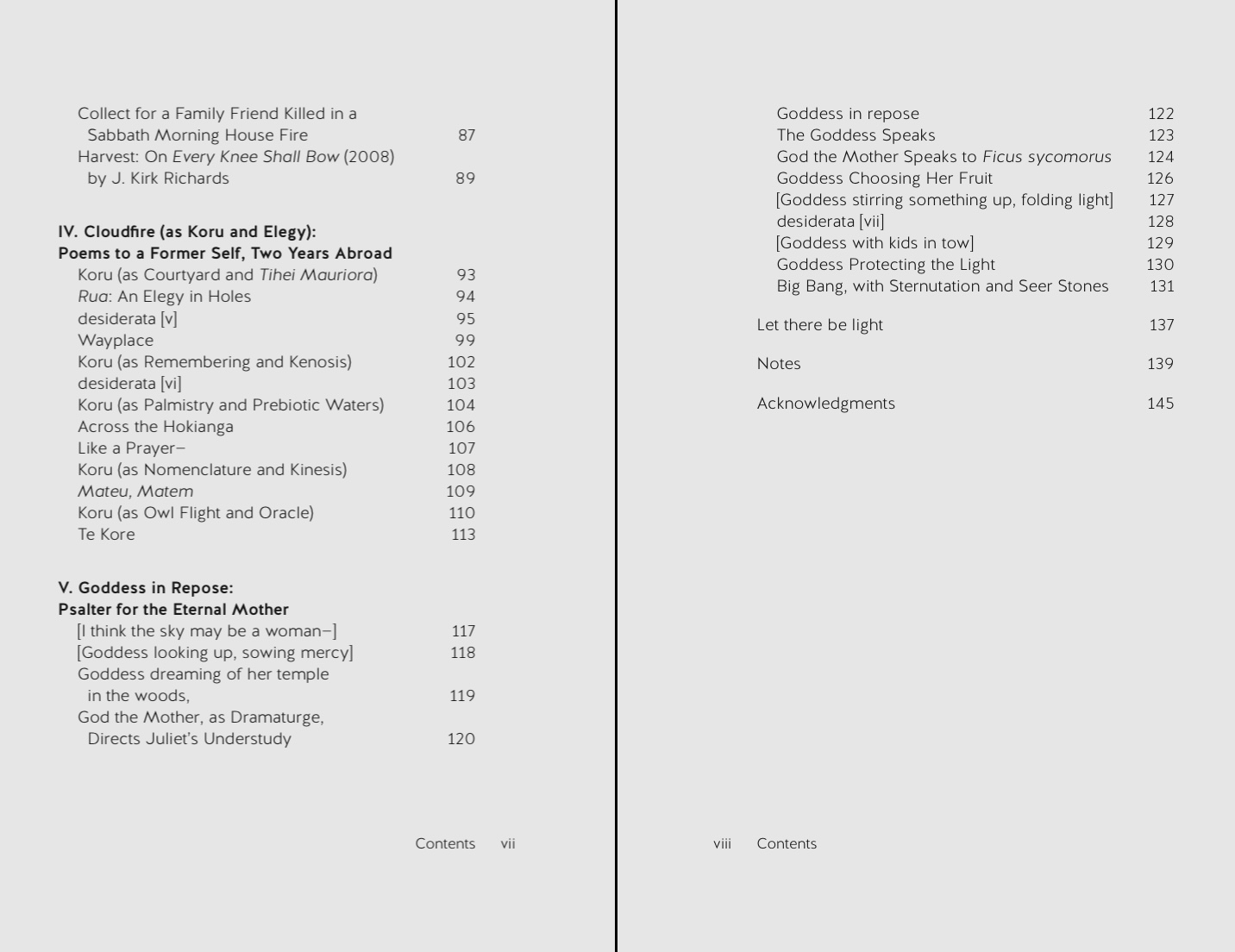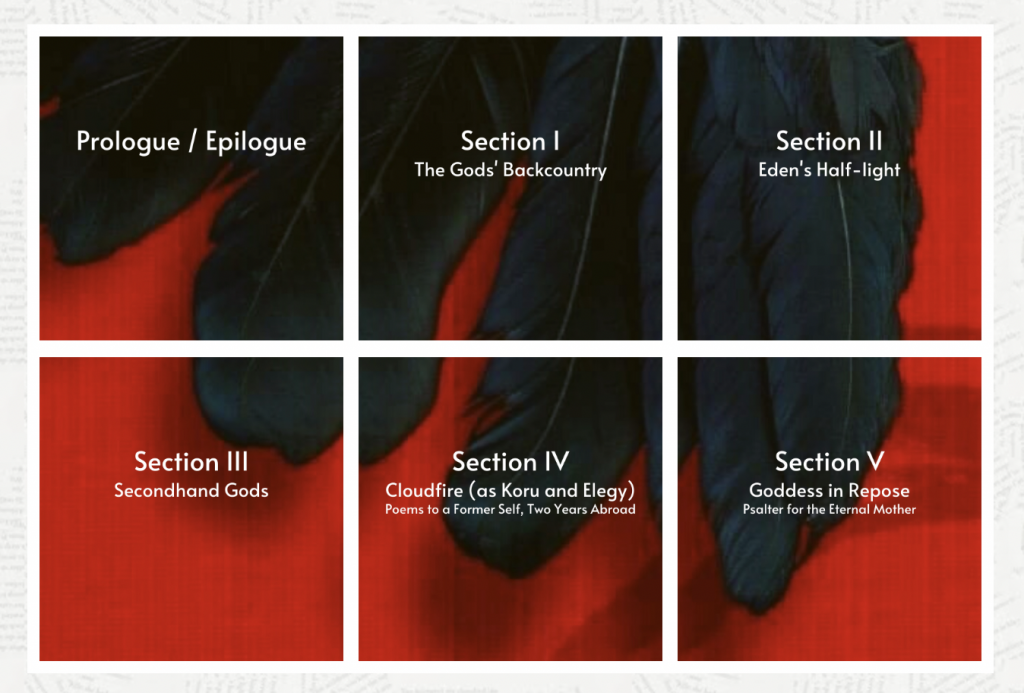Guest post by Tyler Chadwick.
i. Notes first drafted on Easter Sunday, 2022, upon my having received ten print copies of my first poetry collection—

My first hard copies of Litany with Wings just arrived and my heart’s cracking open. It was one thing reading the proof PDFs—which I did again and again while I worked with Andrew Heiss (book designer for BCC Press) to put the finishing touches on the collection. It’s very much another thing to hold the finished product in my hands—taking in Christian Harrison’s bold cover design, seeing the poems on the page, feeling the paper that holds sixteen years of my work.
Thumbing the book’s pages, flipping from end to beginning, I hear the paper whirring. Like wings. . .
*
As suggested by the title, this collection is ultimately a devotional book.
Or rather, it’s a book of devotional lyric poetry.
If devotional books present short daily readings intended to guide readers through moments of meditation and prayer toward deeper devotion to God, the devotional lyric—as a poetic genre—offers readers “the movements of a single mind” (the lyric-“I”) wrestling with difficult metaphysical/theological concerns, including the inevitability of death, “the isolation of selfhood,” and “the varieties of spiritual encounter.” As American (and BYU-based) poet Kimberly Johnson suggests in her introduction to Before the Door of God: An Anthology of Devotional Poetry, these movements aren’t meant to grant readers “miraculous access to the divine” or even necessarily to deepen their religious devotion. Instead, they’re an invitation for readers to sit with the poet in her wrestling by offering their “attention and patience” to her language, which by virtue of her lyric vision and revision presents itself “as an object worthy” of careful contemplation. The devotional lyric thus draws focus from the desired outcomes of meditation and prayer to “the act of the offering” itself, from hope-for divine intervention to hope-in the communal, cosmoplastic agency of the word, as embodied in the published poem.1
As a collection of poetry that takes up and converses with this lyric tradition, Litany with Wings invites readers into my wrestling with concepts of God and the sacred feminine, with religion, Mormon theology, language, faith, my roles as husband, father, brother, son. It invites them into the curiosity manifest in my still-persistent first word, my pointing at the world and asking, “Whazzat? Whazzat? Whazzat? Whazzat?” It invites them into my ongoing faith de/reconstruction as my uncertainties and convictions unfold from that question mark and reach after hope and healing and wholeness, grace and connection, the perpetual work of creation and creativity. It invites them to slow down, to breathe, to experience both the burden2 and the pleasures of words/the word.
*
Given my lifelong immersion in Latter-day Saint-Christianity and given that my book meditates on concerns that are central to my relationship with this faith heritage, it’s apropos for me that the collection released during Holy Week3, when Christians reflect a little more on questions of life, death, and renewal. And it’s apropos that it released during National Poetry Month, when more people turn to and celebrate an art form that’s vital to me and when collective thinking thus opens toward poetry’s public and private functions. I hope readers of all reading interests and faith/non-faith traditions can find something meaningful in the book.
As much as I hope this, though, I’ll also admit that the book is deep down a love letter to Mormonism: the faith tradition that bred me and that I care about, despite an often strained relationship with the institution, its leaders, their teachings, and the LDS community (both local and in general). Thinking of this love alongside my poetic and scholarly inclination to question and reframe things, I’m reminded of a poem by Eugene England, the first Mormon poet I encountered nearly two decades ago in the pages of Dialogue’s first issue:
The Firegiver
God, forgive my pen its trespass,
And I forgive thee the sweet burning
That drives it on through thy dominion.
God, if what it might encompass,
If shapes of love, thy face, or being
Itself are challenged in its question,
Indulge the hand that ventures into flame,
Suffer my searching, for you share the blame.
In this poem and beyond, England revealed to me the potential for a Mormon literature: narrative art that, from a position of critical generosity, addresses and seeks to represent the full range of Mormon experience. England labeled such work “faithful realism,” which he defined as being “realistic, even critical, about Mormon experience but profoundly faithful to the vision and concerns of the restored gospel of Christ.” I use the term “critical generosity” here to suggest a stance toward writing about Mormon subjects that asks not that writers be faithful Latter-day Saints but that they present Mormon subjects with curiosity, complexity, and compassion. It asks writers to resist the easy slide into stereotyping and cliché as well as into cynical nihilism about the Latter-day Saint project while still being willing to celebrate what that project gets right as well as to challenge and question it when its constitutive systems (institutional, doctrinal, cultural) neglect their promise and perpetuate oppressive relationships and social conditions.
England’s vision sparked—and continues to smolder in—my efforts as an editor, critic, and writer laboring to celebrate and develop our literary community. I’m proud to add Litany with Wings to the community catalog. I hope it would hold a place on England’s bookshelf—just like I hope you’ll find a place for it on yours.
ii. Five Things You’ll Find in Litany with Wings
1. Five sections of thirteen poems each, plus a poem that serves as a prologue for the collection and a poem that serves as an epilogue.4


These sixty-seven poems take up and tinker with a range of poetic forms, from the sonnet to the pantoum to the collect to the litany to the American Sentence to the tanka to lyric prose to the list poem—and so on. Most of the poems were published elsewhere before I gathered them into a book;5 some are brand-new, which means you’ll only find them in the book; more, much of the previously-published work has been retouched—sometimes overhauled—to fit within and contribute to the story I’m telling in this book.
2. The first poem I ever published in a professional publication venue—although that poem is very different now than it was when Dialogue printed it sixteen years ago. The 2006 poem is a triptych titled “Fruit” that meditates in third-person on three moments across an allegorical couple’s lifespan:
- the first contemplates the promise of the pair’s gestating child;
- the second, their shared labor—during mid-life, maybe—picking apples from their orchard;
- the third, their return, in old-age, to the orchard where fruit has fallen and decomposed and they wait for death.
The latest iteration is titled “Diptych to a Former Self, Seeking Eden.” While it now has one less section than the earliest version and speaks in the second person, it still explores concerns I hear being raised by the writer of “Fruit”: “How to hear God’s voice” and “How to be remembered.” Both poems also reflect a poetic preoccupation with the Eden mythos: informed by Latter-day Saint temple ritual, which asks participants to imagine themselves Adam or Eve during a re-enactment of the Eden narrative, the poems’ theologies position the pair as every-man and every-woman struggling to make their ways in a fallen world. These are, in part, the ways I wander in Litany with Wings.
I trace the development of “Fruit” and link to its various iterations in this Twitter thread.
3. The most recent poem I’ve published. The collection’s penultimate entry, “Big Bang, with Sternutation and Seer Stones,” appears in the Spring 2022 issue of Dialogue, which explores the Mormon concept of Heavenly Mother. Dialogue has released the poem in four mediums:
- as a PDF of the poem-as-printed,
- as an HTML version of the poem-as-printed,
- as social media-friendly images,
- as an audio recording.
4. Ekphrasis. Lots of ekphrasis. Many of the poems respond to, riff on, reference, or converse with artworks. To offer you easy access to these artworks, I’ve put together a digital companion for the book that includes the images, as well as some other notes.

5. Many references to wings or winged figures. Here they are, in order of appearance:
birdsong, rooster, birdsong, ravens’ wings, quail, cricket, cricket, dove, birds, sparrow, wings, robin, a mourning dove winged earth and air, raven, wings, dove, crickets, dove, grouse, thrush, waterfowl, cherubim, dove, wing-pulse, goose, winged whisper, robin, mourning dove, cherubim-wing soaring, mourning doves, dove, a bird’s just a bird, gulls, cherubim, cherubim, wings, pigeons, pigeons, mourning dove, sparrow, sparrow chick, wing, magpies, raven, wings, wings, lesser coverts, late-winter gulp, mourning dove, finch’s charm, cherubim, cherubim, seraph, mourning dove, cherubim wings, June Bugs, birds, cherubim, mourning dove, bird, geese, geese, wings, firebug, winging their chaplets, dove, crickets, dove swell, spread-eagle, blow flies, wing, kiwi, seraphim wings, owl, owl, owl, she winged from birth’s perch, mourning dove, mourning doves, sparrows, bluebirds, quail, grouse, goose, mourning dove, wing-pulse, Columbidae—
May they whirr you to the Gods’ allelu.
Endnotes
1. To “hope-for” is to practice the individual or collective desire to attain something: an object, a state of being, a relationship, etc. To “hope-in” is to give way to the always unfolding network of relationships in which we dwell and develop with each other. (See Dale Jacobs, “What’s Hope Got to Do With It? Toward a Theory of Hope and Pedagogy.”) (Return to text)
2. I use “burden” here to harmonize with Mormon historian William Mulder: “The poets, playwrights, and prose writers (the novelists, short story writers, and essayists) coming out of the Mormon experience, even marginally, assume what I would call the burden of a Mormon literature, with ‘burden’ suggesting both obligation and opportunity.” (Return to text)
3. It released Thursday, April 14, 2022. (Return to text)
4. The numbers may or may not be significant. (Return to text)
5. You can find these earlier versions in Black Rock & Sage, BYU Studies Quarterly, Dialogue: A Journal of Mormon Thought, Dove Song: Heavenly Mother in Mormon Poetry, Fire in the Pasture: Twenty-first Century Mormon Poets, Handed Down and Altered, Immediate Presence, Irreantum, Likewise Folio, Mormon Artist, Psaltery & Lyre, Victorian Violet Press Poetry Journal, Wilderness Interface Zone, Fieldnotes on Language and Kinship. (Return to text)

Tyler, what an extraordinary invitation to readers. The companion images round out the ekphrastic circle wonderfully.